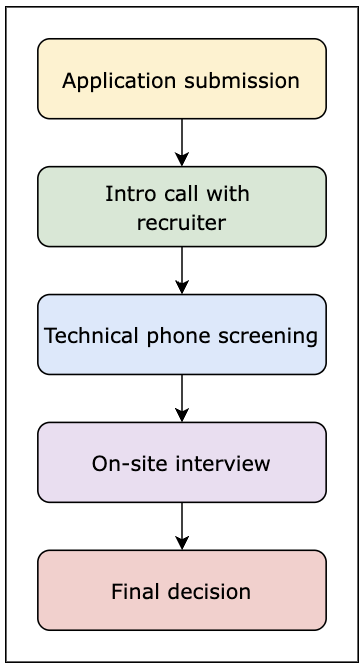Lyft is a leading ride-sharing and transportation company, providing millions of rides across North US. With a strong focus on innovation, sustainability, and customer experience, Lyft continues to shape the future of urban mobility. The company leverages cutting-edge technology like autonomous vehicles, machine learning, and payment systems to enhance its services.
Whether optimizing routing algorithms, improving driver and rider experiences, or developing safety features, Lyft engineers and professionals work on impactful projects that make a tangible difference in everyday life. The company’s mission-driven culture, commitment to diversity, and dynamic work environment make it a desirable workplace for tech professionals.
Landing a job at Lyft is competitive, requiring candidates to navigate a rigorous interview process. However, with the right preparation and strategy, you can succeed. This guide provides a detailed breakdown of Lyft’s hiring process, tips, and resources to help you prepare effectively.
Why work at Lyft?
Lyft offers a unique work environment focusing on innovation, collaboration, and social impact. Here are a few reasons why professionals seek opportunities at Lyft:
- Mission-driven culture: Lyft is committed to reducing carbon emissions and providing affordable, accessible transportation for all.
- Cutting-edge projects: Engineers work on real-world problems involving machine learning, large-scale infrastructure, and customer experience optimization.
- Competitive compensation: Lyft offers competitive salaries, stock options, and performance-based incentives.
- Perks and benefits:
- Flexible work arrangements
- Health, dental, and vision insurance
- Commuter benefits and Lyft ride credits
- Learning and development programs
Lyft’s interview process
Lyft’s hiring process is designed to evaluate technical proficiency, problem-solving abilities, and cultural fit. The process consists of several stages:

1. Application
- Apply via Lyft’s careers page or through referrals.
- Tailor your resume to highlight relevant experience and measurable achievements.
- Ensure your LinkedIn and GitHub profiles (if applicable) align with your application.
2. Recruiter phone screen
- If your resume matches the job requirements, a recruiter will reach out for an initial screening.
- The conversation focuses on your background, career goals, and alignment with Lyft’s mission and culture.
- This is an opportunity to ask questions about the role and work environment.
3. Technical screen (For engineering roles)
- Conducted by a Lyft engineer, this interview evaluates problem-solving skills and coding proficiency.
- Expect to solve 1-2 coding challenges on a platform like CoderPad.
- Questions typically involve algorithms, data structures, and system design fundamentals.
4. On-site interviews (The “Loop”)
- The on-site interview includes multiple rounds covering:
- Coding challenges: Medium-to-advanced algorithmic problems.
- System Design: Design scalable and efficient architectures.
- Behavioral interviews: Assessment of problem-solving approaches and cultural fit.
5. Offer and negotiation
- If you complete all rounds, Lyft extends a job offer.
- The compensation package typically includes base salary, stock options, and other benefits.

A detailed breakdown of each stage
Recruiter phone screen
Objective: Assess your fit for the role and Lyft’s culture.
What to expect:
- Discussion of your experience and career goals.
- Questions about your motivation to join Lyft.
- Overview of Lyft’s culture and values.
Technical screen (Engineering roles)
Objective: Evaluate your technical problem-solving skills.
What to expect:
- 1-2 coding challenges on algorithms, data structures, and real-world problems.
- Possible follow-up questions on time complexity and optimization.
On-site interviews
Objective: Comprehensive evaluation of technical skills, problem-solving, and cultural alignment.
Structure:
- Coding challenges: Medium-to-hard difficulty questions involving arrays, graphs, and dynamic programming.
- System design: Discussion on designing scalable systems, microservices, and data pipelines.
- Behavioral interviews: Questions on past experiences, teamwork, and Lyft’s core values.

Culture fit assessment
Lyft values:
- Diversity and inclusion: Creating equitable opportunities for employees and riders.
- Customer-first mindset: Prioritizing user experience and safety.
- Innovation: Using technology to improve transportation solutions.
Tips for a successful interview
- Ask clarifying questions
- Understanding problem constraints and requirements is crucial. Engage with your interviewer to gather the necessary details.
- Think out loud
- Communicate your thought process. Interviewers appreciate structured and logical reasoning.
- Be open to feedback
- Acknowledge and refine your approach if given feedback during coding or system design exercises.
- Handle roadblocks effectively
- If stuck, step back, break the problem into smaller parts, and iterate toward a solution.
- Use the STAR method
- For behavioral questions, structure your responses using:
- Situation: Context of the problem
- Task: Goal or challenge
- Action: Steps you took
- Result: Outcome and impact
Preparation resources
- Master Data Structures and Algorithms: Focus on graphs, trees, arrays, and dynamic programming.
- Brush up on System Design: Learn distributed system principles and Lyft’s architecture.
- Understand Lyft’s culture: Read company blogs and interview experiences.
- Mock interviews: Practice with Educative mock interviews.
- Time management: Allocate dedicated coding, system design, and behavioral preparation time.
Recommended courses
- Grokking the Coding Interview Patterns: Covers 28 essential coding patterns for FAANG-style interviews.
- Grokking the System Design Interview: Learn how to design scalable systems with real-world applications.
- Grokking the Behavioral Interview: Master structured responses for behavioral and cultural interviews.
This structured preparation plan can increase your chances of securing a role at Lyft. Best of luck with your interview!
